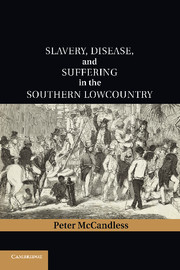Book contents
- Frontmatter
- Contents
- List of Figures
- List of Maps
- Preface
- Acknowledgments
- List of Abbreviations Used in Notes
- MAP 1 The Lowcountry, Charleston, and the Caribbean region
- MAP 2 The South Carolina lowcountry, showing Anglican parishes and slave proportion of population, c. 1760s
- MAP 3 Charleston Harbor, based on a British map, c. 1780
- MAP 4 The Revolutionary War in the South
- PART I TALK ABOUT SUFFERING
- 1 Rhetoric and Reality
- 2 From Paradise to Hospital
- 3 “A Scene of Diseases”
- 4 Wooden Horse
- 5 Revolutionary Fever
- 6 Strangers' Disease
- 7 “A Merciful Provision of the Creator”
- PART II COMBATING PESTILENCE
- Bibliography
- Index
- References
4 - Wooden Horse
Published online by Cambridge University Press: 03 May 2011
- Frontmatter
- Contents
- List of Figures
- List of Maps
- Preface
- Acknowledgments
- List of Abbreviations Used in Notes
- MAP 1 The Lowcountry, Charleston, and the Caribbean region
- MAP 2 The South Carolina lowcountry, showing Anglican parishes and slave proportion of population, c. 1760s
- MAP 3 Charleston Harbor, based on a British map, c. 1780
- MAP 4 The Revolutionary War in the South
- PART I TALK ABOUT SUFFERING
- 1 Rhetoric and Reality
- 2 From Paradise to Hospital
- 3 “A Scene of Diseases”
- 4 Wooden Horse
- 5 Revolutionary Fever
- 6 Strangers' Disease
- 7 “A Merciful Provision of the Creator”
- PART II COMBATING PESTILENCE
- Bibliography
- Index
- References
Summary
The slave trade in the American republic … is to the body politic what yellow fever is to an individual. Every ship that arrives in Charleston is to our nation what the Grecian wooden horse was to Troy.
Thomas Branagan, preface to The Penitential Tyrant, 1805For the last sixteen years the yellow fever has recurred much oftener than in any preceding period. This has not been satisfactorily accounted for…. No visible cause can be designated why it should have recurred almost every year of the last fifteen, and not once as an epidemic disease for the forty years which immediately preceded the year 1792.
David Ramsay, History of South Carolina, 1809“THE PREVAILING DISORDER”
“Its appearance being sudden, the inhabitants were seized with a panic, which caused an immediate sauve qui peut seldom witnessed before. I left, or rather fled, for the sake of my daughters…. They were dreadfully frightened…. Of a population of fifteen thousand, six thousand who could not get away remained, nearly all of whom were more or less seized with the prevailing disorder.” This reaction to a yellow fever epidemic in Savannah in the 1850s conveys the panic the disease could inspire, akin to that aroused by the arrival of plague in the Old World. Like plague, yellow fever could spark a mass exodus from cities, in part because people recognized early on that, unlike malaria or smallpox, it was preeminently an urban disease, in North America at least.
- Type
- Chapter
- Information
- Publisher: Cambridge University PressPrint publication year: 2011

